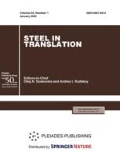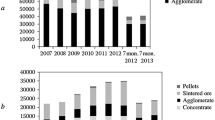Abstract
The creation of metallurgical microworks intended for processing metal scrap to specialized bar iron at an annual output of 50 000 to 100 000 tons is a topical matter. In terms of loading the rolling mill with special kinds of rolled metal used at the regional level, the organization of making grinding balls (bodies) at a microworks fits within its process system almost ideally. This study provides the results of industrial tests aimed at making the end-to-end quality assessment of concast billets, derived rolled stock, and grinding balls at an integrated specialized metallurgical microworks. It is shown that the comprehensive solution of technology-related matters allows making high-quality finished rolled stock. In particular, the optimization of process parameters for making grinding balls of 60 mm in diameter allows reliably attaining hardness group V when using grade 75 steel teemed in jets protected against secondary oxidation.





Similar content being viewed by others
REFERENCES
Smirnov, A.N. and Safonov, V.M., Metallurgical miniworks: past, present, and future, Steel Transl., 2007, vol. 37, no. 1, pp. 47–52.
Tselikov, N.A., Prospective development of metallurgical mini-plants in Russia, Stal’, 1999, no. 6, pp. 58–59.
Lam, M.M., Serov, A.I., Smirnov, E.N., et al., Mastering the production of 40- and 60-mm diam. grinding balls in hardness classes III and IV at the Donetsk Metal-Rolling Plant, Metallurgist, 2016, vol. 60, nos. 3–4, pp. 440–446.
Grishchenko, S.G., Stalinskii, D.V., Rudyuk, A.S., and Medvedev, V.S., Metallurgical micro-plants as a solution of the problem of the production of shaped steel in low-tonnage batches, Stal’, 2008, no. 9, pp. 53–56.
Danieli. https://www.danieli.com/en/. Accessed November 15, 2020.
Minaev, A.A., Nosanev, A.G., Smirnov, E.N., et al., Unit for accelerated cooling of reinforcement bars in the line of a 330 mill after deformation, Metallurgist, 1990, vol. 34, no. 1, p. 17.
Siemens VAI Metals Technologies. http://www.istc. kz/ru/institute/16374/. Accessed November 15, 2020.
Umansky, A.A., Golovatenko, A.V., and Prudnikov, A.N., Analysis of the main trends in the development of the production of grinding balls in Russia and abroad, IOP Conf. Ser.: Mater. Sci. Eng., 2020, vol. 866, no. 1, art. ID 012032.
Sokolov-Sarybai Mining Production Association. https://www.erg.kz/ru/content/ao-ssgpo/ao-ssgpo/. Accessed November 15, 2020.
Smirnov, A.N., Khobta, A.S., Smirnov, E.N., et al., Casting of steel from the tundish of a continuous caster with a sliding gate, Russ. Metall. (Engl. Transl.), 2012, vol. 2012, no. 12, pp. 1–5.
Smirnov, E.N., Smirnov, A.N., Sklyar, V.A., et al., Technical feasibility assessment for roll pass designs in three-high shape-mill stands in modern mini-mills, Metallurgist, 2020, vol. 63, nos. 11–12, pp. 1294–1302.
Liberman, A.L., Dubrovin, I.V., Talanov, I.I., et al., Minimum reduction of continuously casted billets to obtain high-quality rolled products, Metallurg, 1993, no. 4, pp. 31–34.
Smirnov, E.N., Sklyar, V.A., Smirnov, A.N., et al., Effects of decreasing the initial rolling temperature in three-high roughing stands, Steel Transl., 2018, vol. 48, no. 6, pp. 381–387.
Rakhutin, M.G. and Boyko, P.F., Ways to improve assessment methods of the main characteristics of grinding balls, Ugol’, 2017, vol. 12, pp. 49–52.
Ogurtsov, A.P., Gress, A.V., Nesvet, V.V., et al., The structure and chemical heterogeneity of bloom billets casted on the continuous casting machine at the Dnieper Metallurgical Plant, Prots. Lit’ya, 2001, no. 2, pp. 18–28.
Solntsev, Yu.P. and Vologzhanina, S.A., Materialovedenie (Materials Science), Moscow: Akademiya, 2011.
Kovalenko, V.S., Metallograficheskie reaktivy: spravochnik (Metallographic Reactives: Handbook), Moscow: Metallurgiya, 1981, 3rd ed.
Botnikov, S.A., Sovremennyi atlas defektov nepreryvnolitoi zagotovki i prichiny vozniknoveniya proryvov kristallizuyushcheisya korochki metalla (A Modern Atlas of Defects of a Continuously Casted Billet and The Cases of Breakthroughs in a Crystallized Metal Crust), Volgograd, 2011.
Kukhar, V.V., Grushko, A.V., and Vishtak, I.V., Shape indexes for dieless forming of the elongated forgings with sharpened end by tensile drawing with rupture, Solid State Phenom., 2018, vol. 284, pp. 408-415.
Smyrnov, Y.N., Belevitin, V.V., Skliar, V.A., and Orlov, G.A., Physical and computer modeling of a new soft reduction process of continuously cast blooms, J. Chem. Technol. Metall., 2015, vol. 50, no. 6, pp. 589–594.
Shvedov, K.N., Galim’yanov, I.K., and Kazakov-tsev, M.A., Production of grinding balls of high surface and normalized volume hardness, Metallurgist, 2020, vol. 64, nos. 5–6, pp. 499–507.
Galimyanov, I.K., The effect of temperature and structure of a round billet on the split behavior of grinding balls, Chern. Met., 2019, vol. 2019, no. 10, pp. 63–66.
Kukhar, V., Kurpe, O., Klimov, E., et al., Improvement of the method for calculating the metal temperature loss on a Coilbox unit at the rolling on hot strip mills, Int. J. Eng. Technol., 2018, vol. 7, no. 4.3, pp. 35–39. https://doi.org/10.14419/ijet.v7i4.3.19548
Rubtsov, V.Y., Kurochkin, V.V., and Shevchenko, O.Y., Modeling rolling of grinding balls in rolls with continuously changing pitch, Chern. Met., 2020, vol. 2020, no. 6, pp. 36–40.
Lam, M.M., Serov, A.I., Smirnov, E.N., et al., Production of hard (class V) grinding balls at PJSC “DMPZ,” Steel Transl., 2017, vol. 47, no. 5, pp. 325–329.
Malinov, L.S., Malysheva, I.E., Klimov, E.S., et al., Effect of particular combinations of quenching, tempering and carburization on abrasive wear of low-carbon manganese steels with metastable austenite, Mater. Sci. Forum, 2019, vol. 945, pp. 574–578.
Umanskii, A.A., Golovatenko, A.V., Oskolkova, T.N., et al., Influence of macro- and microstructure of steel grinding balls on their impact resistance, Izv. Vyssh. Uchebn. Zaved., Chern. Metall., 2019, vol. 62, no. 4, pp. 283–289.
Author information
Authors and Affiliations
Corresponding author
Additional information
Translated by S. Kuznetsov
About this article
Cite this article
Smirnov, E.N., Smirnov, A.N., Sklyar, V.A. et al. End-to-End Assessment of Product Quality at Integrated Specialized Metallurgical Microworks. Steel Transl. 51, 270–277 (2021). https://doi.org/10.3103/S0967091221040112
Received:
Published:
Issue Date:
DOI: https://doi.org/10.3103/S0967091221040112




